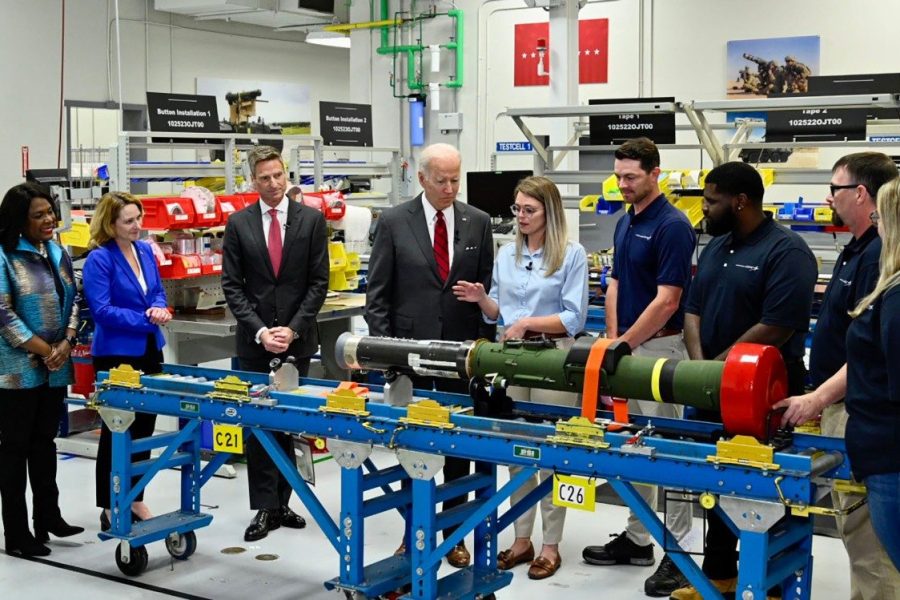The decline of the defense industrial base happened over 30 years—each decrement a logical response to world events—and turning it around to deal with modern realities won’t be quick, according to the first-ever National Defense Industrial Strategy released Jan. 11. But the Biden administration is touting the steps it has taken already to inject more vigor and resiliency into its defense enterprise, even as it prepares to release an NDIS “implementation plan” next month.
“The contraction of the traditional DIB (both commercial and organic) was a generation-long process and it will require another generation to modernize,” according to the forward of the NDIS, penned by Deputy Defense Secretary Kathleen H. Hicks.
The DIB can’t do what it needs to do without an all-of-government approach; something the administration said it has been working on since taking office. Officials touted numerous executive orders, studies and other steps—besides the NDIS itself—to assess and take action needed to match the military rise of China and the emergence of a geopolitical multi-polar world.
The “arsenal of democracy” that “overwhelmed the Axis powers in World War II and contributed significantly to deterring the Soviet Union during the Cold War” has shrunk in size and capacity as a natural reaction to world events, the NDIS notes.
“The ‘peace dividend’ and ‘procurement holiday’ that followed saw dramatic cuts in military force structure, weapons production, and corresponding stockpiles of munitions and materials,” the strategy states. “Most notably, the traditional Defense Industrial Base (DIB) consolidated in the wake of the Secretary of Defense meeting with the major prime contractors and their suppliers in 1993 at what became known as the ‘Last Supper.’”
In that meeting, then-Defense Secretary William Perry warned contractors they should actively look for mergers to adapt to deep cuts in defense spending, as there wouldn’t be enough work for all of them. Since then, the number of U.S. military airplane companies, for example, has dwindled from to eight to three, and many second-tier aircraft component manufacturers have also been vertically integrated with them.
The Pentagon needs to build “a more robust, modernized defense industrial ecosystem” and doing so requires “a dynamic effort across the U.S. government to create the legal and policy conditions that allow new entrants into the defense production and services community,” the NDIS states. “We must solicit entrants of all types: large and small, domestic, and foreign, and those with no previous relationship to the DOD or defense production. This will require reinvigoration and the development of new dialogues and relationships.”
The DIB must be a “competitive advantage” for the U.S and its partners and allies, the Pentagon said.
Major world crises—from the COVID pandemic to Russia’s invasion of Ukraine to the Israel-Hamas war—caused the Pentagon to realize major changes in the DIB were needed, according to the NDIS.
“The COVID-19 crisis demonstrated America’s near-wholesale dependency on other nations for many products and materials crucial to modern life,” the strategy noted. “Longstanding mobilization authorities, such as the Defense Production Act, were needed in the first months of the crisis to prevent expected shortages in medical equipment and other crucial items.”
Then, Russia’s 2022 invasion, “followed the next year by attacks by Hamas on Israel, uncovered a different set of industrial demands and corresponding risks.” All have required surging weapons production far beyond the “just-in-time” levels of the past 30 years, emphasizing minimum quantities at the lowest possible cost, when peer competition was developing but not yet a pacing threat.
The administration is touting the NDIS as now providing “a path that builds on recent progress while remedying remaining gaps and potential shortfalls.”
Steps taken in the last few years have addressed specific problems rather than the defense industry writ large:
- The CHIPS and Science Act provided $53 billion for companies to bring the manufacturing of semiconductor computer chips back to the U.S.; a vulnerability as so much of the chip-making capacity in the world lies with China and nearby Taiwan.
- A trio of executive orders directed new policies to help defense production, strengthen supply chains, and enhance cyber security at all levels of defense manufacturing.
- Another executive order “elaborates and expands on the existing list of factors that the Committee on Foreign Investment in the United States (CFIUS) considers when reviewing transactions for national security risks.” This was aimed at curbing Chinese takeovers of small companies with competitive technologies.
- “Complementing this CFIUS reform, [Executive Order] 14105 regulates outbound investments” in “adversarial defense economies, limiting those adversaries’ ability to compete with the U.S.”
Since one executive order was issued in 2021, nearly $900 million under the Defense Production Act has been “invested in five critical sectors (kinetic capabilities, microelectronics, energy storage and batteries, strategic and critical materials, and castings and forgings),” according to the NDIS.
Other initiatives include the Industrial Base Analysis and Sustainment (IBAS) program, “aimed at maintaining the health of vulnerable DOD suppliers and capabilities.” Another is the Pentagon’s ManTech (Manufacturing Technology program), “a DOD investment portfolio that seeks to develop advanced manufacturing processes, techniques, and equipment to develop, produce, and sustain weapon systems.” There is also a voluntary program under which major contractors help small suppliers use additive manufacturing.
“Guided by this first-of-its-kind” NDIS, the Pentagon “will develop more resilient and innovative supply chains, invest in small- and medium-sized businesses, and strengthen and grow American innovation and manufacturing ecosystems across both the private sector and the government-owned organic industrial base (OIB),” according to the strategy.
“We need to shift from policies rooted in the 20th century that supported a narrow defense industrial base … to a modernized industrial ecosystem that includes the traditional defense contractors—the DIB primes and sub-tier defense contractors who provide equipment and services—and also includes innovative new technology developers; academia; research labs; technical centers; manufacturing centers of excellence; service providers; government-owned, contractor-operated (GOCO) facilities; and finance streams, especially private equity and venture capital,” the strategy states.
An unclassified version of the NDIS implementation plan is promised for February.
